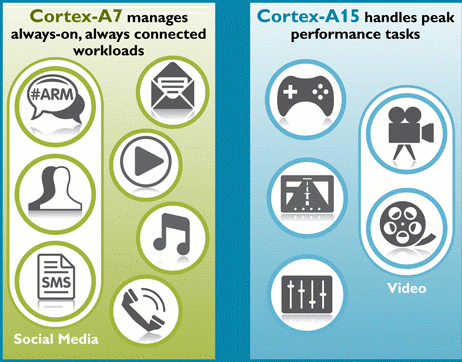ARM uploaded a big.LITTLE demonstration by Nandan Nayampally, Director, Product Marketing. The demo runs the Android 2.3 (Gingerbread) with graphs showing CPU usage and when Cortex A7 / A15 is running. At the beginning Cortex A7 handles the background tasks, and when they start the Android Browser, Cortex A15 is used instead to render the page and once this is done, the system switches back to Cortex A7. Scrolling the webpage will increase CPU usage, but this will still be handled by Cortex A7. They did not have to do any modifications to Android, but they just added a big.LITTLE aware Power Management Driver which will be open sourced and integrated in future version of the linaro kernel.
Android 4.0 Source Code To Be Released When Galaxy Nexus Ships
Google never opened Android 3.0 (Honeycomb) source code. It was probably because this OS was only meant to be used with tablets and they feared people would try to use it on smartphone. The good news is that Android 4.0 (ICS) source code will be made available once the Galaxy Nexus ships. Although I’m not sure what license will be used with Android 4.0, that follows exactly the GPL license requirements since you don’t need to release the source code if you don’t provide the binaries. See Jean-Baptiste Queru (Android Open Source Project ) announcement at https://plus.google.com/112218872649456413744/posts/HB5qQHeNKBQ. In the meantime, the GPL source files that match the Android 4.0 / r14 SDK have been made available: Kernel: https://dl.google.com/dl/android/gpl/android-gpl-kernel-sdk-4.0.1_r1.tgz Platform: https://dl.google.com/dl/android/gpl/android-gpl-platform-sdk-arm-4.0.1_r1.tgz Dev Tools: https://dl.google.com/dl/android/gpl/android-gpl-tools_r14.tgz Extra: https://dl.google.com/dl/android/gpl/android-extra-4.0.1-r14.tgz Like the Android did for all Honeycomb release, this is NOT the full source tree for Android 4.0 (ICS), these are only the GPL parts […]
Leveraging Android’s Linux Heritage at Android Open 2011
The first Android Open Conference took place about 10 days ago. Karim Yaghmour of OperSys published the presentation slides he used during his Android presentations. See Leveraging Android’s Linux Heritage presentation slides below which explain how to use existing Linux application in Android. Those 15 slides cover the following: Goal Rationale Stack Comparison Roadblocks Where do I start? Coexistence Approaches Unresolved / Uncharted Demo You can also check out the Embedded Android Workshop presentation.
Embedded Android Workshop at Android Open 2011
The first Android Open Conference took place about 10 days ago. Karim Yaghmour of OperSys published the presentation slides he used during his Android presentations. See Embedded Android Workshop presentation slides below. Those 159 slides cover the following: Android Basics Android History Android Ecosystem Legal Framework for Android Platform and Hardware requirements Development Tools Concepts and Internals: Android Concepts Framework Intro Native Development Overall Architecture System startup Linux Kernel Hardware Support Native User-Space Dalvik JNI System Server Calling on Services Activity Manager Binder Stock AOSP Apps Android Open Source Projects Tools and location Content Building Build system Adding new applications Images Using adb System Server Services run by System Server Observing the System Server Calling on system services Inside a few system services Creating your own system service Hardware Abstraction Layer Android Framework Location and components Android Customization Custom Toolchains and Dev Kits Rationale SDK generation NDK generation Creating a […]
ARM Unveils Cortex-A7 and big.LITTLE processing
ARM unveiled the Cortex A7, a new core with higher performance than the Cortex A8 (1.5x) and with 5 times less power consumption. It will be used in conjunction with Cortex-A15 Core and allows big.LITTLE processing where the Cortex A7 (companion core) takes care of the low performance, low power tasks (social network, email, SMS, phone calls) and the Cortex A15 kicks in for high performance tasks such as video processing and gaming. Here’s an excerpt of the Cortex A7 / big.LITTLE processing press release: ARM today announced the ARM® Cortex™-A7 MPCore™ processor – the most energy-efficient application class processor ARM has ever developed, and big.LITTLE processing – a flexible approach that redefines the traditional power and performance relationship. The Cortex-A7 processor builds on the low-power leadership established by the Cortex-A8 processor that is at the heart of many of today’s most popular smartphones. A single Cortex-A7 processor delivers 5x […]
Android 4.0 SDK and Platform Highlights
Google has just released Android 4.0 (ICS) preview SDK and platform highlights. Android 4.0 Highlights Summary New User Features: Refined, evolved UI – Common action more visible, new typeface, improved multitaksing and notifications. Home screen folders and favorites tray – New home screen folders offer a new way for users to group their apps and shortcuts logically. Resizable widgets – Interactive widgets are resizable, so users can expand them to show more content or shrink them to save space New lock screen actions – The lock screens now let users do more without unlocking such as accessing the camera app. Quick responses for incoming calls – Respond by pre-written SMS if you are busy during a call Swipe to dismiss notifications, tasks, and browser tabs Improved text input and spell-checking – The softkeyboard now comes with a spell-checker and can automatically correct typos. Powerful voice input engine – Talk to […]
Delete Old Revisions to Reduce Time to First Byte for WordPress Blogs
I’ve already implemented several steps to improve this blog performance: Install W3 Total Cache plugin. Register to CloudFlare CDN to reduce the load on the server. Those two work pretty well, but there was still a problem with the Time to First Byte according to http://www.webpagetest.org. It got an F mark for First Byte Time. Sometimes I would get TTFB (Time To First Byte) of 20 seconds and more. TTFB is synonym of slow back-end processing either because of poorly optimized software or insufficient hardware specs or both. Part of the problem is probably due to my hosting provider (I use a shared hosting) and I sometimes get very high server load in CPanel (e.g. 50 (4 cpus)) whether my blog is running or not. But I found a blog post explaining how to try to reduce the TTFB for WordPress blog by installing Better Delete Revision plugin in order […]
Galaxy Nexus Promotion Video
After Google / Samsung Galaxy Nexus and Android 4.0 Presentation this morning, here’s the Galaxy Nexus Promotion Video.









